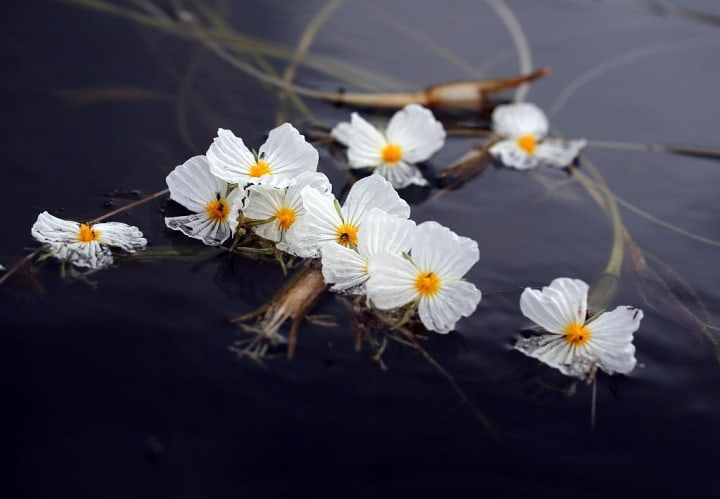
Ottelia acuminata, a unique species native to China, has extremely high requirements for its growth environment and is known as the "touchstone" of water quality. In recent years, with the continuous improvement of water quality in Erhai Lake, continuous cultivation has been achieved in some areas.
On the surface of Erhai Lake in Dali, Yunnan, Ottelia acuminata are in full bloom, entering their prime viewing season. From a distance, they appear like scattered stars, as if a galaxy has descended onto the water's surface. Up close, the delicate and abundant flowers and leaves resemble a moving watercolor painting.

Ottelia acuminata, belonging to the Hydrocharitaceae family, is a submerged aquatic plant unique to China. It has three white, heart-shaped petals that bloom on the water's surface, appearing pure and transparent, with a hint of pale yellow stamens in the center. Its roots grow in the muddy bottom of the water, while its slender stems and leaves sway in the water, resembling a kite string, gently guiding the flowers on the lake's surface.
Ottelia acuminata have incredibly strict requirements for their growth environment and can only thrive in clean water bodies with high transparency, earning them the reputation of being a "touchstone" for water quality. In the past, Ottelia acuminata were widely distributed in lakes, rivers, and ponds in Yunnan, Guizhou, Guangxi, and other regions. However, due to human activities and other factors, their distribution area gradually shrank. Today, Ottelia acuminata are classified as a nationally protected rare and endangered aquatic plant species and are included in the International Union for Conservation of Nature (IUCN) Red List of Endangered Species.

We know that water separates air, and Ottelia acuminata, which grow with the water, bloom on the water's surface, while their roots and stems grow underwater. How do they photosynthesize? Research has found that the diffusion rate of carbon dioxide in water is only one ten-thousandth of that in the air. Although the concentration of carbon dioxide in water is low, most aquatic plants are better at concentrating carbon dioxide than terrestrial plants. The leaves of Ottelia acuminata can absorb dissolved carbon dioxide from the water to meet their photosynthetic needs, while their roots can absorb and fix carbon sources from the muddy bottom, promoting photosynthesis.
For Ottelia acuminata, the most crucial factor affecting their growth is light. Clear and transparent water bodies ensure the smooth progress of their photosynthesis. As the water depth increases, the underwater light available to submerged plants significantly decreases. Ottelia acuminata can adapt to low-light conditions underwater by altering their morphology and physiological characteristics. Research has shown that within a certain range of water depths, Ottelia acuminata leaves grow longer, individual leaf area increases, plant height and stem length all increase with water depth, allowing them to capture more usable light and enhance photosynthetic efficiency. However, if the water quality is not clear and there is insufficient light penetration through the water's surface, Ottelia acuminata will struggle to survive, no matter how they adapt their own morphology and physiological characteristics. This is why Ottelia acuminata is often referred to as a "touchstone" for water quality.
In recent years, with increased conservation efforts, the water quality of Erhai Lake has continued to improve, and the natural distribution area of Ottelia acuminata has expanded to approximately 250,000 square meters. The clean water quality has also laid the foundation for artificial cultivation of Ottelia acuminata in some areas of the Erhai Lake basin. In Erhai County, Dali Bai Autonomous Prefecture, local authorities have supported and cultivated Ottelia acuminata as an ecological industry while advancing water quality protection and agricultural transformation and upgrading. Currently, in Songqu Village, Zuosuo Town, Erhai County, Ottelia acuminata cultivation has been achieved on a large scale, with a total area of more than 1,500 mu (approximately 100 hectares) and an annual output value of over 18 million yuan.
In summary, Ottelia acuminata, as a unique and fragile aquatic species, play a crucial role in indicating and maintaining water quality. With dedicated conservation efforts and successful artificial cultivation, they are not only contributing to ecological balance but also becoming a source of economic income in certain regions. The success story in Erhai provides valuable lessons for other areas looking to protect their aquatic ecosystems and develop ecological industries.
About the Creator
tim8888
Hello, I'm a passionate writer and explorer who loves creating innovative content. I hope you enjoy my articles. Feel free to reach out if you have any questions or want to chat. Thanks for visiting!






Comments
There are no comments for this story
Be the first to respond and start the conversation.